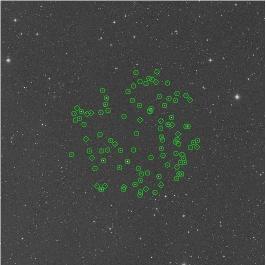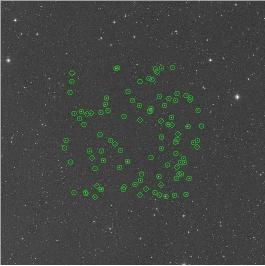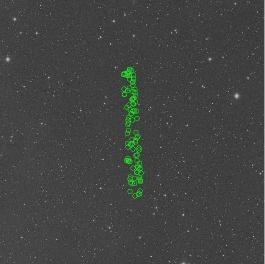
|
WCSTools 4.0:
Building Astrometry and Catalogs into Pipelines
Douglas Mink
Smithsonian Astrophysical Observatory
|
Abstract
The WCSTools package was originally developed to create and access
world coordinate systems in FITS image headers. In order to do that,
programs and subroutines which access, modify, and extract information
from FITS image headers and data, extract information from catalogs of
sources, and manipulate sky, image, and time coordinates have been
developed. Package functionality has always been available at both
the subroutine level for developers of other packages, such as ds9,
and at the scripting level for use in data processing pipelines.
On the occasion of a major upgrade to the latest level of Mark
Calabretta's WCSLIB library, lesser-known features, such
as data and time format conversions and command line name to coordinate
resolution will be presented.
|
Introduction
The WCSTools package was originally created to add world coordinate systems
to FITS astronomical images when it turned out that there weren't very
many ground-based telescope optical images which could be matched against
radio or spacecraft images. The basic functions of the package have been
described in a series of papers by Douglas Mink in 1997, 1999, and 2002.
The WCS projection capabilities of the package rest on Mark Calabretta's
WCSLIB subroutines which implement the FITS-WCS standards laid out in
Calabretta and Griesen 2002 and Griesen and Calabretta 2002. Over the past
several years, Calabretta has rewritten his subroutines, but WCSTools has
continued to use the old ones, which continued to work well almost all
of the time.
In order to support features added in the spectral WCS paper
(Griesen et al 2005), major upgrades have been made to WCSLIB, and WCSTools
is being updated to interface with those modifications. Although these
changes should be invisible to users, this seemed like a good time to point
out some lesser-known features of WCSTools. The number of catalogs
supported has continued to expand and the number of search
modes have expanded. Coordinate conversion has always been present, but
time conversions have been added. Manipulation of image data as well
as image headers is possible, always with the intention of maintaining or
improving the match of an images appearance to that of the sky.
All of this functionality is available through subroutine calls as well
as by command line invocation of the named programs.
Catalog Support
Originally, only the HST Guide Star Catalog was supported. Soon the need for
WCS's for deeper, narrow field images led to the implementation of on-demand
extraction of positions of sources from the Digitized Sky Survey. Since this
process was rather time-consuming, deep all-sky catalogs have been supported
since the USNO-A1.0. In WCStools, catalogs are supported in their native
format through a single API.
scat, which searches catalogs,
imcat,
which finds the catalog stars in the region defined by an images WCS,
imwcs, which fits a WCS to an image, and
immatch, which matches
sources found in an image with a WCS to a catalog, all use a standard
catalog interface.
Deep all-sky catalogs, used with recent epoch narrow field images, include the
USNO-B1.0 Catalog (1,0366,366,767 stars, 83 Megabytes),
GSC 2.2 Catalog (998,402,801 stars, over 80 Megabytes),
2MASS Point Source Catalog (470,992,970 stars, 32 Megabytes), and the
USNO-A2.0 Catalog (526,280,881 stars, 6 Gigabytes). The GSC 2.2 catalog at
the Space Telescope Science Institute can be accessed over the web by
scat.
Astrometric catalogs with accurate proper motions include the
UCAC2 Catalog (48,366,996 stars, 2 Gigabytes) and the
Tycho-2 Catalog (2,539,913 stars, 529 Megabytes).
Photometric catalogs with accurate magnitudes across the sky include the
2MASS Point Source Catalog and Tycho-2 Catalog for the entire sky. For
deep photometry in some parts of the sky, the Sloane Digital Sky Survey
Photometry Catalog (53,000,000 sources) at SDSS can be accessed over web
by scat.
Catalogs which are reasonably complete at bright end and work well
for wide field images include the
HST Guide Star Catalog (25,541,952 sources, 1.2 Gigabytes)
the PPM Catalog (378,910 stars with proper motions, 22 Megabytes), and the
SAO Catalog (258,996 stars with proper motions, 16 Megabytes).
Web access to the NASA Extragalactic Database (NED) and SIMBAD,
now included with WCSTools, gives command line access
to their vast catalogs of named objects, for example:
> nedpos m44
08:40:22.198 +19:40:19.43}
> simpos m44
08:40:24.000 +19:41:00.00 J2000}
You can convert coordinates, just as in
scat access to any other catalog:
> nedpos -g m44
205.910635 +32.479519 Galactic}
> simpos -e m44
127.346995 +1.291450 Ecliptic}
Catalog Search Options
There are three ways
scat can specify a search region on the sky,
as shown in Figure 1:

|
a circle on the sky, with center and radius specified
> scat -c ub1 -tn 10000 -r 900 10:00 85:00 J2000}
|

|
a square (or rectangle) on the sky, with center and half-side(s) specified
> scat -c ub1 -tn 10000 -r -900 10:00 85:00 J2000}
|

|
or as a rectangle in coordinates, with center and half-sides specified
> scat -c ub1 -tn 10000 -rr 900,900 10:00 85:00 J2000}
|
Time Conversion
As modern synoptic surveys of the sky begin and older
surveys, such as the Harvard Plate Collection, are brought into
the digital age, manipulation of times, their units and their formats
has become more important. The
getdate task converts time
formats and systems. For example, the current time in FITS ISO format:
> getdate now2fd
2005-09-30T17:49:53.000}
can be converted to Julian Date
> getdate fd2jd 2005-09-30T17:49:53.000
2453644.24297}
or Modified Julian Date
> getdate fd2mjd 2005-09-30T17:49:53
53643.74297}
Conversions between UTC, TT, and TAI are also possible.
Image Manipulation
WCSTools' imrot task performs
simple 90, 180, and 270 degree rotations
and both horizontal and vertical reflections without modifying pixel values.
A common use of this task is to align multiple outputs of imaging detectors
which are read out in different directions. The operation is also built into
the imwcs task so that a WCS can be
added to an input image no matter
what its orientation returning an output image with north-up, east-left.
Input image source catalogs, such as can be created using SExtractor
(Bertin & Arnouts 1996), created from the input image, are also rotated
and/or reflected just like the image.
The getfits task extracts an
arbitrary segment of an image while
preserving the world coordinate system. Because the task is WCS-cognizant,
the center of the region to be extracted can be specified by either the
sky coordinates or image pixel coordinates. The original coordinates of
the pixels of the image are preserved through an additional FITS WCS
with a "P" suffix on the keywords.
Image Distortion
The proposed standard for dealing with distortion in FITS world coordinate
systems is still in flux (Calabretta et al 2004), but the Spitzer Space
Telescope needed a way to represent distortions in IRAC images, so they
created a model based on the proposed standard in 2003 and it was implemented
and tested in WCSTools before launch. Since images can be remapped by
WCSTools' remap task from any
supported projection into a more standard projection, such as plane
tangent, the Spitzer pipeline uses that task to remap distorted images
into a simpler WCS.
WCSTools Updates
Extensive online documentation, with examples for every
task in the package is available at
http://tdc-www.harvard.edu/software/wcstools/
To keep users informed about the status of the package,
two email lists have been created:
- wcstools-announce will only announce software updates
- wcstools will allow users to help each other and let me know what
features need more work or more documentation.
To subscribe, email {\it majordomo@cfa.harvard.edu} with one of the following
in the body of the message:
subscribe wcstools
subscribe wcstools-announce
References
Bertin, E. & Arnouts, S. 1996, Astronomy and Astrophysics Supplement,
117, 393
Calabretta. M.R. & Greisen, E.W. 2002, Astronomy and Astropyhsycs,
375, 1077
Calabretta. M.R., Valdes, F., Greisen, E.W., Allen, S.L., 2004, ADASS XIII, 551
Greisen, E.W. & Calabretta, M.R. 2002, Astronomy and Astrohysics, 375, 1061
Greisen, E.W, Calabretta, M.R., Valdes F., & Allen, S.L., 2005,
accepted for publication in Astronomy and Astrophysics
Mink, D. 1997, ADASS VI, 249
Mink, D. 1999, ADASS VIII, 498
Mink, D. 2002, ADASS XI, 169


